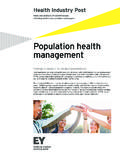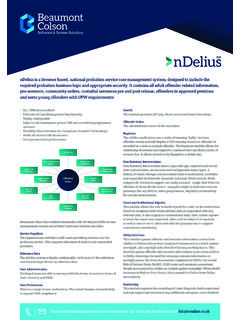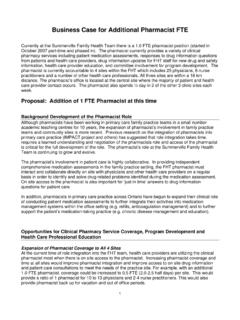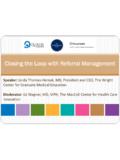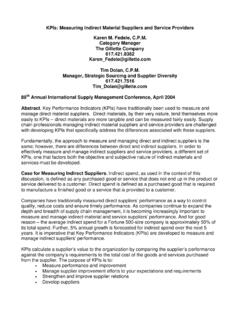Transcription of WHO/UNICEF JOINT STATEMENT
1 WHO/UNICEF JOINT STATEMENT Integrated Community case management (iCCM)An equity-focused strategy to improve access to essential treatment services for children2 Bringing treatment closer to homeDespite the progress made in reducing under-five mortality, three quarters of under-five deaths are still due to a handful of causes specifically, pneumonia, diarrhoea, malaria and newborn conditions. Malnutrition is associated with about one third of the correct treatment of childhood pneumonia, diarrhoea and malaria is one of the most powerful interventions to reduce However, in most high-mortality countries, facility-based services alone do not provide adequate access to treatment,2,3 and most importantly, not within the crucial window of 24 hours after onset of symp- toms.
2 If child mortality is to be adequately add- ressed, the challenge of access must be taken on. Community health workers appropriately trained, supervised and supported with an uninterrupted supply of medicines and equipment can identify and correctly treat most children who have the conditions mentioned In 2004, the World Health Organization (WHO) and the United Nations Children s Fund ( unicef ) issued JOINT statements on the management of pneumonia in community settings5 and the clinical management of acute diarrhoea,6 both of which highlighted the important role of community-based treatment. A recent review by the Child Health Epidemiology Reference Group (CHERG) estimated that community management of all cases of childhood pneumonia could result in a 70 per cent reduction in mortality from pneumonia in children less than 5 years Community case management (CCM) of malaria can reduce overall and malaria-specific under-five mortality by 40 and 60 per cent, respectively, and severe malaria morbidity by 53 per ,9 Oral rehydration salts (ORS)
3 And zinc are effective against diarrhoea mortality in home and community settings, with ORS estimated to prevent 70 to 90 per cent of deaths due to acute watery diarrhoea,10 and zinc estimated to decrease diarrhoea mortality by per these reasons, unicef , WHO and partners working in an increasing number of countries are supporting the iCCM strategy to train, supply and supervise front-line workers to treat children for both diarrhoea and pneumonia, as well as for malaria in malaria-affected countries, using ORS and zinc, oral antibiotics, and artemisinin-based combination therapy (ACT). In addition, the availability of high-quality rapid diagnostic tests for malaria (RDTs) has made it possible to test for malaria at the community level.
4 RDT use will make the need for high-quality integrated treatment, including iCCM, even more pressing, to ensure adequate health worker response to febrile children with or without malaria. Finally, iCCM also enables community health workers to identify children with severe acute malnutrition through the assessment of mid-upper-arm circumference (MUAC).Current contextThe number of children dying worldwide contin-ues to decrease, and while this is encouraging, the decline has been slow, stagnating or even revers-ing in many countries, particularly in sub-Saharan Africa. While new preventive interventions especially pneumococcal conjugate and rotavirus vaccines will also help reduce mortality, prompt and effective treatment of pneumonia, diarrhoea and malaria remains delivery of health services is often weakest where the needs are greatest, and low coverage of the most needed interventions results in a signifi-cant unmet need for treatment of these major child killers.
5 In developing countries, current treatment levels are unacceptably low: Only 39 per cent of children receive correct treat-ment for Only 30 per cent of children with suspected pneu-monia receive an Less than 20 per cent of children with fever in sub-Saharan Africa received a finger/heel stick for malaria testing, in 11 out of 13 countries with avail-able data in the and disadvantaged children without access to facility-based case management are at even greater risk, as shown in the following figure. This STATEMENT presents the latest evidence for integrated community case management (iCCM) of childhood illness, describes the necessary programme elements and support tools for effective implementation, and lays out actions that countries and partners can take to support the implementation of iCCM at for iCCMP rogrammatic experience shows that an integrat-ed strategy can be effective in achieving high treatment coverage and delivering high-quality care to sick children in the community.
6 In Nepal, which has more than 20 years of experience in community-based management of child illness, 69 per cent of the under-five population has access to treatment,15 and both the case fatality rate for acute diarrhoea and the proportion of severe pneumonia among acute respiratory infection cases across the country have decreased In Ghana, 92 per cent of caregivers of sick children sought treatment from community-based agents trained to manage pneumonia and malaria. Indeed, most sought care for their children within 24 hours of onset of In Zambia, a CCM study on pneumonia and malaria found that 68 per cent of children with pneumonia received 3 Notes: Estimates are based on a subset of 59 countries for ORT+CF and 34 countries for the anti-biotics indicator, with wealth data for the period 2006 2011 covering 65 per cent and 50 per cent, respectively, of the total under-five population in developing countries (excluding China, for which comparable data are not available).
7 * Refers to ORS packets, recommended home-made fluids or increased fluids.** Excludes : unicef global databases, of children aged 0 59 months with diarrhoea receiving oral rehydration therapy* with continued feeding, 2006 2011 Proportion of children aged 0 59 months with suspected pneumonia receiving antibiotics, 2006 20110%20%40%60%80%100%414648303634 AfricaAsia**Developingcountries**0%20%40 %60%80%100%453325281119 AfricaAsia**Developingcountries**Poorest 20%Richest 20%early and appropriate treatment from community health workers, and that overtreatment of malaria significantly In Ethiopia, workers deployed in remote communities delivered two and a half times as many treatments for the three diseases than all the facility-based providers in the same The proportion of children receiv-ing ACTs globally is also increasing, although significant gaps adequate training and supervision, community health workers can retain the skills and knowledge necessary to provide appropri-ate care.
8 In Malawi, 68 per cent of classifications of common illnesses by Health Surveillance Assistants were in agreement with assessments done by physicians, and 63 per cent of children were prescribed appropriate community health workers can increase coverage and access to treatmentCommunity health workers are an effective option for investment as part of a comprehensive primary health care system. However, community case management should not be viewed as an inexpen-sive or low-cost measure. Effective implementa-tion requires policy support, training, supervision, performance maintenance and regular supplies.
9 In addition, community health workers are increas-ingly responsible for many health and develop-ment tasks, and expansion of their duties needs to be carefully considered in this that decide to deploy community health workers to increase coverage of iCCM should: Examine the policy options: Existing policies may need to be modified, or new policies put in place, to allow non-medical community health workers to administer on existing programmes and initiatives: In many countries, community-based programmes for single diseases, such as malaria, have been institutionalized and even scaled up. In these cases, the experience gained from malaria management can serve as a foundation to which the case management of pneumonia and diarrhoea can be the quality of care: Community health workers need support to maintain and enhance their skills in assessing and managing child illness.
10 Refresher training should be undertaken at periodic intervals, and supportive supervision needs to be planned and carried out on a regular basis. New approaches such as peer supervi-sion, clinical mentoring and the use of electronic devices ( , cell phones and DVDs) are being used or tried out in some adequate and uninterrupted supplies and medicines: It is critical that medicines for iCCM meet the particular needs of young children and their families, and that appropriate formulations, dosages and packaging designed to improve adherence are utilized. Coordinated efforts to consolidate systems and support the supply chain management function can be aided by a function-ing logistics management information and assess: A systematic approach to gathering, aggregating, analysing and report-ing data will serve to map and identify key gaps in treatment coverage.











